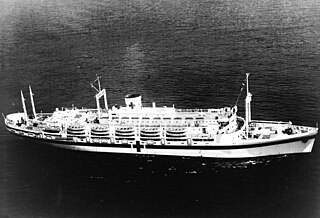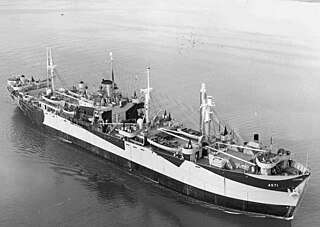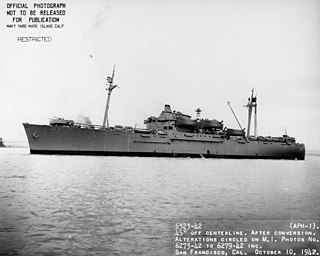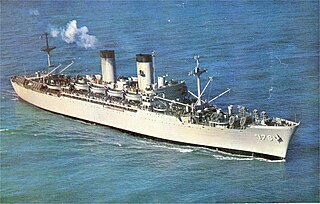
The fifth USS Boston was a protected cruiser and one of the first steel warships of the "New Navy" of the 1880s. In some references she is combined with Atlanta as the Atlanta class, in others as the Boston class.

The second USS Mercy (AH-8) was a Comfort-class hospital ship laid down under Maritime Commission contract by Consolidated Steel Corporation at the Wilmington Yard, Wilmington, California, on 4 February 1943. She was acquired by the US Navy from the Maritime Commission on 25 March 1943 and launched the same day, sponsored by Lieutenant Doris M. Yetter, NC, USN, who had been a prisoner of war on Guam in 1941. She was converted from a cargo ship to a hospital ship by Los Angeles Shipbuilding & Drydock Company, San Pedro, California and commissioned 7 August 1944.

The sixth USS Relief (AH-1), the first ship of the United States Navy designed and built from the keel up as a hospital ship, was laid down 14 June 1917 by the Philadelphia Navy Yard; launched 23 December 1919; and commissioned 28 December 1920 at Philadelphia, Commander Richmond C. Holcomb, Medical Corps, USN, in command.

USS Hope (AH-7) was a Comfort-class hospital ship launched under Maritime Commission contract by Consolidated Steel Corporation, Wilmington, California, 30 August 1943; sponsored by Miss Martha L. Floyd; acquired by the Navy the same day for conversion to a hospital ship by U.S. Naval Dry Dock, Terminal Island, Calif.; and commissioned 15 August 1944.

USS Haven (AH-12) was the lead ship of her class of hospital ships built for the U.S. Navy during World War II. Laid down as SS Marine Hawk, she was transferred from the Maritime Commission for conversion to a hospital ship, and served in that capacity through the end of the war. She was redesignated APH-112 in June 1946 for participation in Operation Crossroads, returning to her original AP-12 designation in October 1946. Haven participated in the Korean War and eventually ending her military career acting as a floating hospital in Long Beach, California. She was later converted to a chemical carrier and scrapped in 1987.

USS Waukesha (AKA-84) was a Tolland-class attack cargo ship in service with the United States Navy from 1945 to 1946. She was sold into commercial service and was scrapped in 1970.

USS Samaritan (AH-10) was a hospital ship that served with the US Navy in World War II. Prior to that, she served as a US Navy transport ship under the name USS Chaumont (AP-5).

USS Consolation (AH-15) was a Haven-class hospital ship originally in service with the United States Navy from 1945 to 1955. In 1960 she was chartered to the People to People Health Foundation and renamed SS Hope and served for another 14 years until being scrapped in 1975.

The USS Repose (AH-16) was a Haven-class hospital ship in service with the United States Navy. It was active from May 1945 to January 1950, from October 1950 to December 1954, and from October 1965 to May 1970.

USS Pinkney (APH-2) was a Tryon-class evacuation transport that was assigned to the U.S. Navy during World War II. Pinkney served in the Pacific Ocean theatre of operations and returned home safely post-war with six battle stars but missing 18 crew members who were killed in action.

USS Deede (DE-263) was an Evarts-class destroyer escort in the United States Navy.

USS Baham (AK-122/AG-71) was a Basilan-class auxiliary ship, converted from a Liberty ship, commissioned by the United States Navy for service in World War II. She was first named after former Florida resident Elizabeth C. Bellamy, the daughter of General William Croom, and wife of Doctor Samuel C. Bellamy. She was renamed and commissioned after Baham, a star in constellation Pegasus. She was responsible for delivering troops, goods and equipment to locations in the war zone.

USS Tryon (APH-1) was laid down as SS Alcoa Courier on 26 March 1941, by the Moore Dry Dock Company, Oakland, California and launched on 21 October 1941 sponsored by Mrs. Roy G. Hunt. After the attack on Pearl Harbor, she was designated for U.S. Navy use and assigned the name Comfort in June 1942. Comfort was renamed Tryon on 13 August 1942, acquired by the U.S. Navy on 29 September 1942, and commissioned on 30 September 1942.

USS Sheridan (APA-51) was an Ormsby-class attack transport that served with the US Navy during World War II.

USS Crescent City (AP-40/APA-21) was the lead ship of the Crescent City-class attack transports that served with the US Navy during World War II. The ship was built as the cargo and passenger liner Delorleans for the Mississippi Shipping Company's Delta Line. After brief commercial operation the ship was among 28 vessels requisitioned in June 1941 for the Navy and the Army. The Navy renamed the ship Crescent City, a popular nickname for New Orleans, Louisiana, upon commissioning 10 October 1941. The ship was decommissioned and laid up in 1948 before being loaned to the California Maritime Academy to serve as a training ship 1971–1995 and then transferred to a foundation in a failed art colony project. The ship left California for Texas scrapping in 2012.

USS General J. C. Breckinridge (AP-176) was a troopship that served with the United States Navy in World War II, the Korean War and the Vietnam War. In October 1949 she was redesignated T-AP-176 but retained her Navy crew. Her namesake was United States Marine Corps Lieutenant General James Carson Breckinridge (1877-1942), who was the grandson of John Cabell Breckinridge, who served as Vice President of the United States from 1857 to 1861.

The Type C4-class ship were the largest cargo ships built by the United States Maritime Commission (MARCOM) during World War II. The design was originally developed for the American-Hawaiian Lines in 1941, but in late 1941 the plans were taken over by the MARCOM.

USS Antaeus (AS-21/AG-67) was a commercial passenger liner that the United States Navy acquired in World War II. She was SS Saint John from 1932 until 1941 before the US Navy acquired her and commissioned her as Antaeus. From 1941 to 1943, she was a submarine tender; she was later redesignated AG-67 and used as a troop transport from 1943 to 1944. In 1945, she was converted to a hospital ship, renamed USS Rescue (AH-18), and served in the Pacific War. Decommissioned in 1946, she was sold for scrap in 1958.

The second USS Comfort (AH-6) was launched 18 March 1943 by Consolidated Steel Corporation, Wilmington, Los Angeles, under a Maritime Commission contract; sponsored by First Lieutenant E. Hatchitt, USAMC; transferred to the Navy the same day; converted to a hospital ship by Bethlehem Steel Co., San Pedro, Calif.; and commissioned 5 May 1944.



















